Related Research Articles

Leonardo di ser Piero da Vinci was an Italian polymath of the High Renaissance who was active as a painter, draughtsman, engineer, scientist, theorist, sculptor, and architect. While his fame initially rested on his achievements as a painter, he has also become known for his notebooks, in which he made drawings and notes on a variety of subjects, including anatomy, astronomy, botany, cartography, painting, and palaeontology. Leonardo is widely regarded to have been a genius who epitomised the Renaissance humanist ideal, and his collective works comprise a contribution to later generations of artists matched only by that of his younger contemporary Michelangelo.

The Mona Lisa is a half-length portrait painting by Italian artist Leonardo da Vinci. Considered an archetypal masterpiece of the Italian Renaissance, it has been described as "the best known, the most visited, the most written about, the most sung about, [and] the most parodied work of art in the world." The painting's novel qualities include the subject's enigmatic expression, monumentality of the composition, the subtle modelling of forms, and the atmospheric illusionism.
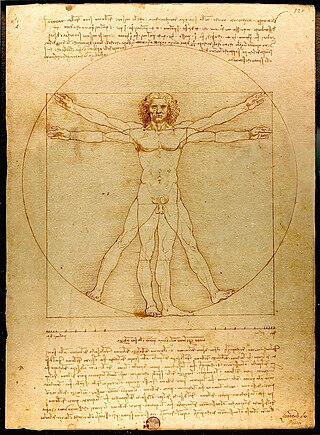
The Vitruvian Man is a drawing by the Italian Renaissance artist and scientist Leonardo da Vinci, dated to c. 1490. Inspired by the writings of the ancient Roman architect Vitruvius, the drawing depicts a nude man in two superimposed positions with his arms and legs apart and inscribed in both a circle and square. It was described by the art historian Carmen C. Bambach as "justly ranked among the all-time iconic images of Western civilization". Although not the only known drawing of a man inspired by the writings of Vitruvius, the work is a unique synthesis of artistic and scientific ideals and often considered an archetypal representation of the High Renaissance.

The Virgin of the Rocks, sometimes the Madonna of the Rocks, is the name of two paintings by the Italian Renaissance artist Leonardo da Vinci, of the same subject, with a composition which is identical except for several significant details. The version generally considered the prime version, the earlier of the two, is unrestored and hangs in the Louvre in Paris. The other, which was restored between 2008 and 2010, hangs in the National Gallery, London. The works are often known as the Louvre Virgin of the Rocks and London Virgin of the Rocks respectively. The paintings are both nearly 2 metres high and are painted in oils. Both were originally painted on wooden panels, but the Louvre version has been transferred to canvas.

The Virgin and Child with Saint Anne is an unfinished oil painting by High Renaissance artist Leonardo da Vinci, dated to c. 1501–1519. It depicts Saint Anne, her daughter the Virgin Mary and the infant Jesus. Christ is shown grappling with a sacrificial lamb symbolizing his Passion as the Virgin tries to restrain him. The painting was commissioned as the high altarpiece for the Church of Santissima Annunziata in Florence and its theme had long preoccupied Leonardo.
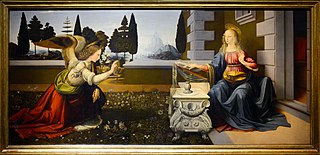
The Annunciation is a painting by the Italian Renaissance artist Leonardo da Vinci, dated to c. 1472–1476. Leonardo's earliest extant major work, it was completed in Florence while he was an apprentice in the studio of Andrea del Verrocchio. The painting was made using oil and tempera on a large poplar panel and depicts the Annunciation, a popular biblical subject in 15th-century Florence. Since 1867 it has been housed in the Uffizi in Florence, the city where it was created. Though the work has been criticized for inaccuracies in its composition, it is among the best-known portrayals of the Annunciation in Christian art.

The Lady with an Ermine is a portrait painting by the Italian Renaissance artist Leonardo da Vinci. Dated to c. 1489–1491, the work is painted in oils on a panel of walnut wood. Its subject is Cecilia Gallerani, a mistress of Ludovico Sforza, Duke of Milan; Leonardo was painter to the Sforza court in Milan at the time of its execution. It is the second of only four surviving portraits of women painted by Leonardo, the others being Ginevra de' Benci, La Belle Ferronnière and the Mona Lisa.

The Portrait of a Musician is an unfinished painting by the Italian Renaissance artist Leonardo da Vinci, dated to c. 1483–1487. Produced while Leonardo was in Milan, the work is painted in oils, and perhaps tempera, on a small panel of walnut wood. It is his only known male portrait painting, and the identity of its sitter has been closely debated among scholars.

The Virgin and Child with Saint Anne and Saint John the Baptist, sometimes called the Burlington House Cartoon, is a drawing by Leonardo da Vinci. The drawing is in charcoal and black and white chalk, on eight sheets of paper that are glued together. Because of its large size and format the drawing is presumed to be a cartoon for a painting. No painting by Leonardo exists that is based directly on this cartoon, although the drawing may have been in preparation for a now lost or unexecuted painting commissioned by Louis XII. The drawing is the only extant larger-scale drawing by the artist.

The Isleworth Mona Lisa is an early 16th-century oil on canvas painting depicting the same subject as Leonardo da Vinci's Mona Lisa, though with the subject depicted as being a younger age. The painting is thought to have been brought from Italy to England in the 1780s, and came into public view in 1913 when the English connoisseur Hugh Blaker acquired it from a manor house in Somerset, where it was thought to have been hanging for over a century. The painting would eventually adopt its unofficial name of Isleworth Mona Lisa from Blaker's studio being in Isleworth, West London. Since the 1910s, experts in various fields, as well as the collectors who have acquired ownership of the painting, have asserted that the major elements of the painting are the work of Leonardo himself, as an earlier version of the Mona Lisa.

Saint Jerome in the Wilderness is an unfinished painting by the Italian Renaissance artist Leonardo da Vinci, dated c. 1480–1490. A recent study linked to the Lady with an Ermine carried out by Leonardo da Vinci at the same time supports this hypothesis. The composition of the painting has been drafted in monochrome onto the primed wooden panel. At an unknown date after Leonardo's death, the panel was cut into five pieces before eventually being restored into its original form.

La Scapigliata is an unfinished painting generally attributed to the Italian High Renaissance artist Leonardo da Vinci, and dated c. 1506–1508. Painted in oil, umber, and white lead pigments on a small poplar wood panel, its attribution remains controversial, with several experts attributing the work to a pupil of Leonardo. The painting has been admired for its captivating beauty, mysterious demeanor, and mastery of sfumato.

Salvator Mundi is a painting attributed in whole or part to the Italian High Renaissance artist Leonardo da Vinci, dated c. 1499–1510. Long thought to be a copy of a lost original veiled with overpainting, it was rediscovered, restored, and included in an exhibition of Leonardo's work at the National Gallery, London, in 2011–2012. Christie's, which sold the work in 2017, stated that most leading scholars consider it an original work by Leonardo, but this attribution has been disputed by other leading specialists, some of whom propose that he only contributed certain elements; others believe that the extensive restoration prevents a definitive attribution.
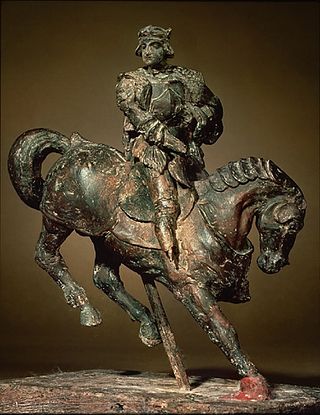
Horse and Rider is a beeswax sculpture created 1508–1511 depicting a rider on a horse. The history of the sculpture is unknown before the 20th century. The work has been attributed to Leonardo da Vinci by the Italian art historian Carlo Pedretti, though most other art historians disagree with the attribution.
Frank Zöllner is a German art historian. He is among the leading authorities on the life and works of Leonardo da Vinci, about whom he has written numerous publications. These include book-length studies on the Mona Lisa and one of the two modern catalogues raisonnés of Leonardo's works, the other being by Pietro C. Marani.

Work on the conservation and restoration of Leonardo da Vinci's The Last Supper mural, much of it more harmful than helpful, has been carried out over many centuries, and continues. Completed in the late 15th century by the Renaissance artist Leonardo da Vinci, the mural is located in the refectory of the Convent of Santa Maria delle Grazie, Milan, Italy. The Last Supper was commissioned by Ludovico Sforza, Duke of Milan in 1495, as part of a series of renovations to the convent with the intention that the location would become the Sforza family mausoleum. Painting began in 1495 and continued until 1498.

The Head of the Virgin in Three-Quarter View Facing Right is a drawing on paper in pierre noir pencil and red chalk, attributed to the Florentine painter Leonardo da Vinci and kept at the Metropolitan Museum of Art in New York.
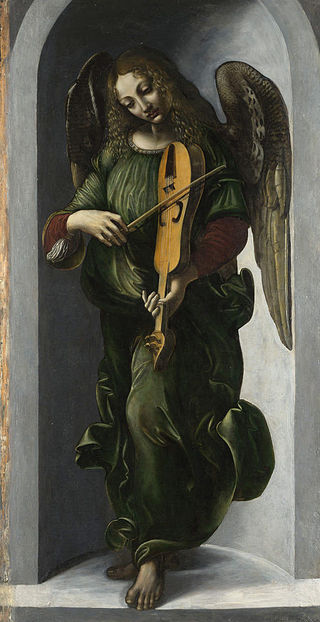
The Angel musicians are two paintings created in the late 15th century to frame Leonardo da Vinci's Virgin of the Rocks. Their purpose was to decorate the side panels of the Altarpiece in the Chapel of the Immaculate Conception, created to decorate a chapel in the Church of San Francesco Grande in Milan. Separated from their original altarpiece at the very end of the 18th century, they have been in the National Gallery in London since 1898.
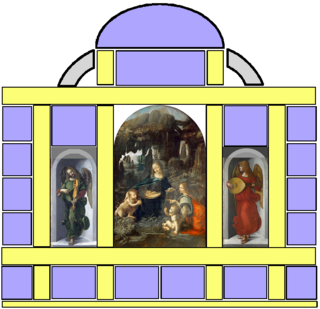
The altarpiece in the Chapel of the Immaculate Conception in the Church of San Francesco Grande, Milan, was an altarpiece built between 1480 and 1482, decorated between 1483 and 1508, and dismantled in the early 19th century.
References
Citations
- 1 2 "Pietro C. Marani". University of Chicago Press. Archived from the original on 4 September 2022. Retrieved 4 September 2022.
- ↑ "Marani, Pietro Cesare". Identifiants et Référentiels pour l'Enseignement supérieur et la Recherche. Archived from the original on 11 October 2022. Retrieved 10 October 2022.
- 1 2 3 4 Veltman 2008, p. 383.
- 1 2 3 4 5 "Pietro C. Marani". Association Internationale De La Couleur Milan. Archived from the original on 4 October 2022. Retrieved 4 September 2022.
- ↑ Fargo & Landrus 2013, § "Catalogue Raisonnés".
- ↑ Kemp 2018, p. 57.
Sources
- Kemp, Martin (2018). Living with Leonardo: Fifty Years of Sanity and Insanity in the Art World and Beyond. London: Thames & Hudson. ISBN 978-0500774236.
- Veltman, Kim H. (2008). "Leonardo da Vinci: A Review". Leonardo . 41 (4): 381–388. doi:10.1162/leon.2008.41.4.381. JSTOR 20206632. S2CID 57572644.
- Fargo, Claire; Landrus, Matthew (2013). "Leonardo da Vinci" . Oxford Bibliographies: Renaissance and Reformation. Oxford: Oxford University Press. doi:10.1093/OBO/9780195399301-0151.(subscription required)